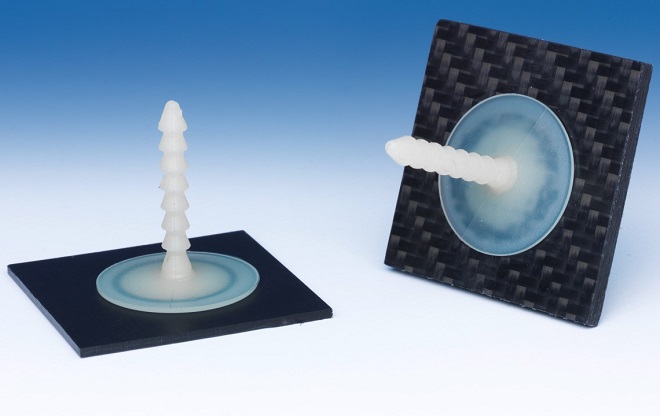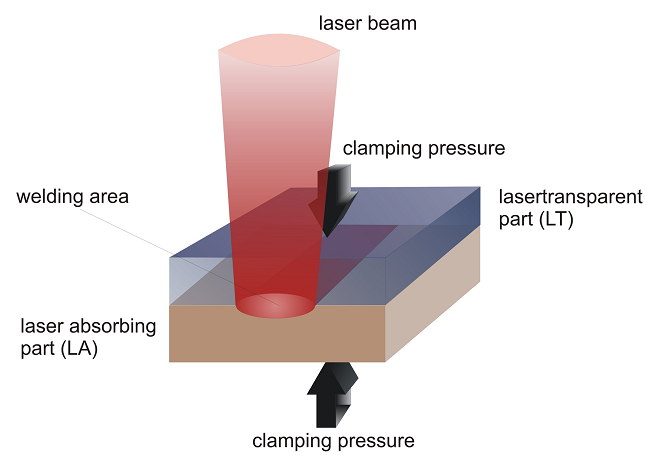January 9th, 2014
The Laser Zentrum Hannover e.V. (LZH) and seven other partners have successfully completed the research project „LaWocs“. From December 2010 to November 2013, the national and international project partners worked intensely on „Laser transmission welding of thermoplastic composite structures“.
Lightweight construction with potential for aircraft, automobiles and ships
Goals connected with the field of environmental protection are ambitious – and they must be. This includes saving energy by reducing fuel consumption, and related with this, reducing CO2 emissions. This is a challenge for all industrial manufacturers, from aircraft to automobile to ship construction. In order to achieve these goals, new lightweight construction concepts based on using carbon fiber reinforced plastics (CFRP) or glass fiber reinforced plastics (GFRP) are being developed. These materials offer not only a high potential for reducing weight, but they also have excellent mechanical properties. Thus, CFRP and GFRP are constantly becoming more and more important for industry. A good understanding of these materials combined with suitable production concepts are thus an important research topic across the globe.
LaWocs: Laser transmission welding of thermoplastic composite structures
In the last three years, the Eurostars project LaWocs „Laser transmission welding of thermoplastic composite structures“ was the first research project to investigate laser based welding of fiber reinforced materials. The goal of the project was to design a project chain from modifying the construction of components to the process, to adapting the material to the process, to optimizing the laser welding process itself.
Up to now, for example, adhesives have been used to join fiber reinforced materials, meaning the material surfaces must be intensively prepared, and a drying stage is necessary. An alternative to adhesives is mechanical joining using rivets or screws. However, this requires holes being drilled in the components, which interrupt the flow of forces along the reinforcing fibers. Laser transmission welding of thermoplastic fiber reinforced materials offers many advantages, including high flexibility, making it possible to weld complicated geometries. Furthermore, laser processing is non-tactile, i.e. forces are not applied to the workpiece. Also, laser energy can be specifically applied only to places where a welding seam is necessary. Process control can use a non-tactile pyrometer for measuring temperatures, for example to successfully weld thermoplastic GFRP with CFRP. Thus, laser welding of composite materials can be used to simplify production processes. At the same time, this method has a high automation potential, and production with short cycle rates and high piece rates are possible, important pre-requisites for use in industrial manufacturing.

Laser welded interior aircraft pins
European competency all along the line
European cooperation made it possible to consider all aspects of the individual processing steps for fiber composite workpieces in one research project. Within the framework of the three year joint project, new materials were designed, which are both suitable for laser transmission welding, but still maintain good mechanical properties. Additionally, investigations on a better understanding of the welding process for different thermoplastic materials were carried out, and used for the development of the welding parameters. Thus, the project partners ELEMENT, KVE, EPL, TODS, DEVA, TENCATE, FIBRE and the LZH were able, for the first time, to synergetically implement and optimize all the subprocesses in the material and process development and component construction, including material testing.
The welding process
One of the main goals of the project was the development of a laser based process for welding fiber reinforced composite structures, and belonged to the responsibilities of the scientists in the Composites Group at the LZH. In order to carry out these welding processes, the optical characteristics of thermoplastic materials were used. They are partially transparent in the near infrared spectral range (NIR), and the correct laser radiation can be transmitted through the first welding partner. The laser radiation is then absorbed by the carbon fibers or the soot particles in the second welding partner, and the electromagnetic radiation is transformed into heat. Due to heat conduction between both welding partners, the respective plastics melt, and a welding seam is formed. The Composites Group has developed, among other things, processes for welding low transparency fiber composite materials, including glass fiber reinforced organic plastic sheets based on a polyetherimide (PEI) structure, which can be welded up to a material thickness of 2.4 mm. Furthermore, processes have been developed to weld thermoplastic angles and braces to components made of formed organic plastic sheets.
Laser welded aircraft pins – a model for the future
Hundreds of thousands of so called aircraft pins are produced yearly for use in wide body aircraft. These pins are an example of the actual components that are in the focus of the LaWocs project. These pins are used for example to connect flooring panels to fire safety equipment and insulation material. Tests have already shown that laser welded pins have a higher strength than pins joined using adhesives, meaning that these pins can be used for weight reduction. Laser transmission welding is thus an excellent solution for fast welding of thermoplastic fiber reinforced materials. Work in this project offer an excellent foundation for the development of an automated process for the industrial manufacturing of these lightweight components, making it a resource efficient, environmentally friendly development in the transportation field.
Project partners:
- DEVA - DEVA Kunststoff-Technik GmbH (Germany)
- ELEMENT - Element Materials Technology (Great Britain)
- EPL - EPL Composite Solutions Ltd (Great Britain)
- Fibre - Faserinstitut Bremen e.V. (Germany)
- KVE - Kok & Van Engelen Composite Structures BV (the Netherlands)
- LZH - Laser Zentrum Hannover e. V. (Germany)
- TENCATE - TenCate Advanced Composites BV (the Netherlands)
- TODS - Tods Aerospace Limited (Great Britain)
The LZH would like to thank the German Federal Ministry of Education and Research (BMBF) for financial support of the Eurostars project LaWocs (FKZ: 01QE1002D).
Source:












